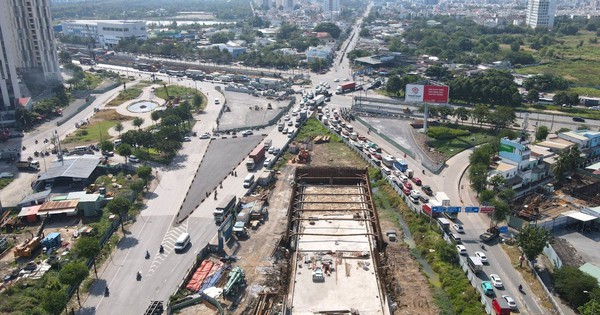On January 31, Vice Chairman of Ho Chi Minh City People’s Committee Vo Van Hoan chaired a scientific workshop to contribute opinions on the draft Ho Chi Minh City Master Plan for the period 2021 – 2030, with a vision to 2050.
Addition of Beltway 5
At the workshop, Nguyen Van Danh, Vice Chairman of Binh Duong Provincial People’s Committee, suggested that Ho Chi Minh City has developed almost to the point of reaching Beltway 2. Therefore, the area between Beltway 3 and Beltway 4 is the most suitable area for industrial development, national and regional infrastructure.
In Binh Duong, infrastructure has been invested and developed rapidly, and the industrial zone has reached Beltway 3 and is rapidly developing towards Beltway 4. According to the proposal of the planning consulting unit of Binh Duong province, the Ho Chi Minh City region needs to add a Beltway 5 to meet the development requirements in the next phase.
Nguyen Van Danh pointed out that the Government has decided to invest in the Chon Thanh – Gia Nghia expressway, the Ho Chi Minh City – Thu Dau Mot – Chon Thanh expressway, and the National Road 13C, so there must be a gradual calculation of Beltway 5. “If there is no early investment direction for Beltway 5 in Ho Chi Minh City, then Binh Duong will become a major congestion point when major traffic arteries converge here. Therefore, it is necessary to update the planning of Beltway 5,” emphasized Nguyen Van Danh.

The An Phu intersection project is expected to maximize connectivity with provinces in the Southeast
Mr. Duong Van Thang, Vice Chairman of Tay Ninh Provincial People’s Committee, assessed that the transportation infrastructure between Ho Chi Minh City and provinces in the region has not been seamlessly connected, especially the connection with Tay Ninh is urgent. He proposed that Ho Chi Minh City determine the planning of infrastructure and concentrate resources to develop important corridors such as the Ho Chi Minh City – Moc Bai expressway, the Xuyen A route, and synchronized waterway and railway infrastructure. Tay Ninh province also wants Ho Chi Minh City to concentrate investment in the Saigon River bank route to connect synchronously with Binh Duong and Tay Ninh in the future.
Ms. Phan Thi Kim Oanh, Deputy Director of the Department of Planning and Investment of Binh Phuoc province, affirmed that the planning of Ho Chi Minh City plays an important role and has a special significance for the overall development of the region. She proposed that Ho Chi Minh City pay attention to supplement and update the National Road 13B, 13C, and 14C routes in the comprehensive planning report.
Calculating multiple cities within the city
Ph.D. Architect Ngo Viet Nam Son believes that in addition to the central urban areas that have long been the focal point of the city’s economic and social development, Thu Duc City is a new potential, the fastest growing and breakthrough area in the future.
Based on that, Architect Ngo Viet Nam Son proposed to plan 2 more cities within Ho Chi Minh City that have enough potential to contribute to the city’s economic and social development equivalent to Thu Duc City. Specifically, he proposed a city in the South including Nha Be district, District 7, District 8, and a part of the southern part of Binh Chanh district; and a city in the North including Hoc Mon district, Cu Chi district, and the northern part of Binh Chanh district. Thus, Ho Chi Minh City will have a special type of urban area in the central area and 3 cities within the city including Thu Duc City, the southern part, and the northern part. The southern part will develop marine economy while the northern part will develop the economy in connection with Cambodia and the Mekong Delta.
Having the same viewpoint, Dr. Tran Du Lich, Head of the Planning Advisory Group, suggested that the Ho Chi Minh City People’s Committee organize a workshop with both the integrated planning group (Ho Chi Minh City planning for the period 2021 – 2030, with a vision to 2050) and the general city planning until 2040, with a vision to 2060, to discuss the spatial development orientation, including how many urban areas there will be in the future city as well as the criteria for determination. This is a very important issue that affects the entire development of the city.
Creating new value
Deputy Chairman of Ho Chi Minh City People’s Committee Vo Van Hoan affirmed that this time the social and economic planning must be associated with green and digital economy. Each economic sector must have new and outstanding elements. New industries must be developed (semiconductors, electronics, semiconductors…), supporting industries, and high-tech application industries. In addition, in agriculture, the focus is on developing the rural area of the city as high-tech agriculture.
“Ho Chi Minh City must make breakthroughs in industry to create new value and new momentum for the whole country, as the country’s economic locomotive,” said Mr. Vo Van Hoan.
Regarding regional connectivity, Mr. Vo Van Hoan believed that it includes economic space and “hard” space, “soft” space. In this, the city must be a high-quality service provider including healthcare, education, tourism, finance, logistics. He emphasized that all healthcare, cultural, educational facilities… must be improved to meet national and international standards. People from elsewhere come to Ho Chi Minh City for high-quality healthcare to create new value. Solving healthcare problems not only solves the problem for the city, provinces, the whole country, but also the region…
According to Mr. Hoan, “soft” connectivity is reflected in development orientation, priority development sectors, human resources training; developing brands to provide orientation for the entire region…
Regarding urban development space, Mr. Vo Van Hoan affirmed that the proposal of Dr. Tran Du Lich is very good for the city planning. Therefore, he will report to the Chairman of Ho Chi Minh City People’s Committee to convene a meeting of the 2 consulting groups, 2 teams of counterarguments about the planning of Ho Chi Minh City for the period 2021 – 2030, with a vision to 2050 and the general planning of Ho Chi Minh City until 2040, with a vision to 2060.
“Hai bên sẽ cùng làm rõ về định hướng không gian phát triển hạ tầng, định hướng không gian phát triển các ngành kinh tế… để xem vấn đề nào còn khác biệt thì thảo luận hướng đến thống nhất. Hai quy hoạch này được trình phê duyệt cùng thời điểm sẽ thuận lợi cho công tác triển khai sau quy hoạch của thành phố,”
Both sides will clarify the orientation of infrastructure development space, the orientation of development space for economic sectors… to discuss which issues are still different for the purpose of reaching consensus. Having these two plans approved at the same time will facilitate the implementation after the city planning,” he added.
TS Vu Thanh Tu Anh, Fulbright University, believes that urban development space is the most important issue in planning and needs to be deeply discussed.
More effective in regional connectivity
Professor Nguyen Trong Hoai, a member of the counter-planning consulting group, believes that after 20 years, regional connectivity in Ho Chi Minh City is still weak. According to him, the key point of planning is the “hard” infrastructure issue for the city such as transportation, logistics… Besides, it is necessary to clarify the issues in regional connectivity that are advantageous to the city such as healthcare, healthcare services, workforce training.
Also a member of the counter-planning consulting group, Dr. Vu Anh Tuan commented that the traffic congestion points on the connecting route of Binh Duong, Ho Chi Minh City, Dong Nai, Ba Ria – Vung Tau are National Road 13, Ho Chi Minh City – Long Thanh – Dau Giay expressway; the connection with Tay Ninh is congested on National Road 22… Therefore, these congestion points need to be resolved.












